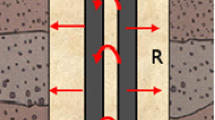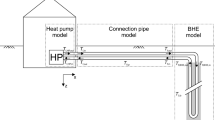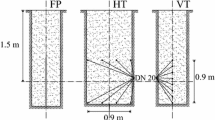Abstract
Residential geothermal ground-source heat pumps have been used for nearly 30 years as a low-cost, environmentally friendly alternative to traditional fossil-fuel systems. However, the limitation on a wider range of acceptance of the technology is the cost of the installation of a piping network through which the energy is transferred between the soil and the coolant. This cost is proportional to the piping length. We formulate a new mathematical modeling framework that calculates a characteristic streamwise length based on the geometry of the system, the operating conditions, and the material properties of the system materials and effective properties of the surrounding soil using a vertical concentric geothermal heat exchanger as an example. These concentric systems consist of a core flow (from the residence), which flows from the ground surface to the base of the well, and an annular return region in which the heat exchange between the fluid and the soil is expected to take place. Two modeling scenarios are considered: steady-state temperature profiles in the annular fluid region if the radial thermal resistance between the fluid and soil is fixed; a quasi-steady fluid temperature that captures the radial heat transfer from the fluid to the soil. For the first case, we find that the characteristic length is determined by the smallest eigenvalue of the separable thermal problem, where the velocity profile is laminar and there is no thermal transport between the core and the fluid. When this core-annular heat transfer is possible, the eigenvalue problem no longer satisfies the conditions for Sturm–Liouville theory, and through direct computation we find that energy transferred from the annular flow to the core reduces the temperature change. In the second case, we find that the temperature change is reduced over time, as the soil temperature near the exchanger responds to the energy transport. In both cases, the best thermal transport takes place when the annular gap is small. The impact of these results on system design considerations is discussed.












Similar content being viewed by others
References
Huttrer GW (1997) Geothermal heat pumps: an increasingly successful technology. Renew Energy 10(2–3):481–488
Omer AM (2008) Ground-source heat pumps systems and applications. Renew Sustain Energy Rev 12(2):344–371
Bear J (1988) Dynamics of fluids in porous media. Dover Publications, New York
Ingersoll LR, Zobel OJ, Ingersoll AC (1948) Heat conduction, with engineering and geological applications. McGraw-Hill Book Co., New York
Carslaw HS, Jaeger JC (1959) Conduction of heat in solids. Oxford Science Publications, Oxford
Lamarche L, Beauchamp B (2007) New solutions for the short-time analysis of geothermal vertical boreholes. Int J Heat Mass Transf 50(7–8):1408–1419
Dobson M, O’Neal DL, Aldred W (1995) A modified analytical method for simulating cyclic operation of vertical U-tube ground-coupled heat pumps. In: ASME international solar energy conference, Maui
Yavuzturk C, Spitler JD (1999) A short time step response factor model for vertical ground loop heat exchangers. ASHRAE Trans 105:475–485
Sutton MG, Nutter DW, Couvillion RJ, Davis RK (2002) An algorithm for approximating the performance of vertical bore heat exchangers installed in a stratified geological regime. ASHRAE Trans 108:177–194
Zeng H, Diao N, Fang Z (2003) Heat transfer analysis of boreholes in vertical ground heat exchangers. Int J Heat Mass Transf 46:4467–4481
Michopoulos A, Kyriakis N (2009) Predicting the fluid temperature at the exit of the vertical ground heat exchangers. Appl Energy 86:2065–2070
Zanchini E, Lazzari S, Priarone A (2010) Effects of flow direction and thermal short-circuiting on the performance of small coaxial ground heat exchangers. Renew Energy 35(6):1255–1265
Ortan A, Quenneville-Bélair V, Tilley BS, Townsend J (2009) On Taylor dispersion effects for transient solutions in geothermal heating systems. Int J Heat Mass Transf 52:5072
Tilley BS, Baumann T (2012) On temperature attenuation in staged open-loop wells. Renew Energy 46:416–423
Taylor GI (1953) Dispersion of soluble matter in solvent flowing slowly through a tube. Proc R Soc Lond Ser A Math Phys Sci 219(1137):186–203
Taylor GI (1954) Conditions under which dispersion of a solute in a stream of solvent can be used to measure molecular diffusion. Proc R Soc Lond Ser A Math Phys Sci 225(1163):473–477
Aris R (1956) On the dispersion of a solute in a fluid flowing through a tube. Proceedings of the Royal Society of London. Series A. Mathematical and Physical Sciences 235(1200):67–77
Brenner MP, Stone HA (2000) Modern classical physics through the work of G.I Taylor. Phys Today 53:30–35
Marcotte D, Pasquier P (2008) On the estimation of thermal resistance in borehole thermal conductivity test. Renew Energy 33:2407–2415
Marcotte D, Pasquier P, Sheriff F, Bernier M (2010) The importance of axial effects for borehole design of geothermal heat-pump systems. Renew Energy 35:763–770
Lemmon EW, McLinden MO, Friend DG Thermophysical properties of fluid systems. In: Linstrom PJ, Mallard WG (eds) NIST chemistry WebBook, NIST standard reference database number 69, National Institute of Standards and Technology, Gaithersburg. http://webbook.nist.gov (retrieved July 2012)
Peters-Lidard CD, Blackburn E, Liand X, Wood EF (1998) The effect of soil thermal conductivity parameterization on surface energy fluxes and temperatures. J Atmos Sci 55:1209–1224
Krishnamoorthy C, Rao R, Ghajar A (2007) Single-phase heat transfer in micro-tubes: a critical review. In: Proceedings of the 2007 ASME-JSME thermal engineering summer heat transfer conference
Incropera F, DeWitt D, Bergman T, Levine A (2006) Fundamentals of heat and mass transfer, 6th edn. Wiley, New York
Kays WM, Crawford ME (1993) Convective heat and mass transfer, 3rd edn. McGraw-Hill, New York
Boyce WE, DiPrima RC (2008) Elementary differential equations and boundary value problems, 7th edn. Wiley, New York
Carslaw HS (1921) Introduction to the theory of Fourier series and integrals. In: Carslaw HS (ed) Introduction to the theory of Fourier’s series and integrals and the mathematical theory of the conduction of heat. Macmillan, London
Abramowitz M, Stegun IA (1972) Handbook of mathematical functions. Dover Publications, New York
Buckmire R (2003) Investigation of nonstandard, Mickens-type, finite-difference schemes for singular boundary value problems in spherical or spherical coordinates. Numer Methods Partial Differ Equ 19(3):380–398
Acknowledgments
We gratefully thank Kevin Maher of the New England Geothermal Professional Association (NEGPA) and Dr. Stephen Mabee at the University of Massachusetts Amherst for discussions about geothermal systems. We gratefully acknowledge the support of the National Science Foundation, Award DMS-1004795.
Author information
Authors and Affiliations
Corresponding author
Appendix: Finite difference computational model
Appendix: Finite difference computational model
To find the steady-state temperature in the core and in the annular region for \(k \ne 0\) with Nu constant, we computationally model system (45) and (46), subject to boundary conditions (47)–(50). Our approach is to use finite difference methods in the radial variable \(r\) and the axial variable \(z\). Note that (45) is computationally stable when solving the problem backward in \(z\). We prescribe a specific temperature profile along \(z = 1, 0 < r < 1-\epsilon \), and a well-posed computational solution can be found. However, the temperature profile in the annular region is computationally stable when solving the problem forward in \(z\). Hence, any direct computational approach to find the temperature profiles for both regions simultaneously is likely to be computationally unstable.
Instead, we adopt an iterative approach to find the steady-state temperature profiles. To do this, we introduce a heat flux within the inner tube region \(1-\epsilon < r < 1\), which depends on \(z\). If this flux is denoted by \(q_j(z)\) during the \(j\mathrm{th}\) iteration of the scheme, then we solve the following initial-value problems for each iteration:
where \( A_2 = \theta ^{(1)}(1-\epsilon ,0)+q_j(0)\) allows continuity of temperature at the inner tube wall for \(z = 0\) and satisfies boundary condition (30). Note that this formulation satisfies jump condition (43).
The goal is to form a converging sequence of functions \(q_j\) such that the last condition (44) is satisfied. To do this, we set
and use a fixed-point iteration to determine the next approximation to the sequence \(q_j\):
The iteration is said to converge when a quadrature approximation to the error,
is below a specified tolerance \(\tau < 10^{-5}\).
To determine the solution of (72) subject to (73), and analogously the solution of (75) subject to (76), with \(q_j(z)\) given, we discretize the spatial domain with a uniform grid interior to the domain boundary in \(r\) and use a Crank–Nicolson scheme, where the time variable is given by \(z\) oriented in the same direction as the velocity field, and a nonstandard Mickens-type scheme is used for the radial differential operator [29]. That is, for the core fluid we march the solution from \(z = 1\) to \(z = 0\), and for the annular fluid we march from \(z = 0\) to \(z = 1\). For clarity in describing the Crank–Nicolson method, let us consider the canonical heat equation
We approximate \(u(r_m,t_n) \approx U_m^n\), and we let \(\Delta r = r_{m+1}-r_m\), \(\Delta t = t_{n+1}-t_n\) be a constant for positive integers \(m,n \le N\), resulting in a uniform grid on \(0 < r < 1\), \(0 < t < T\). We then implement Crank–Nicolson for (81)
where \(\mathbf{U}^n = (U_1^n, U_2^n, \ldots , U_N^n)\) is the spatial vector of the solution at time \(t = t_n\), and the \(m\mathrm{th}\) element of the nonstandard discretization for \(\mathcal L \) is given by
The vector \(\mathbf{B}\) corresponds to the inhomogeneous boundary conditions that result from points not on the computational grid (e.g., \(r = r_o = 0, r = r_{N+1} = 1\)). In the simulations shown in this paper, \(N = 200\) for each radial domain \(0 < r < 1-\epsilon \) and \(1 < r < R\), along with \(N = 200\) in the axial domain.
Rights and permissions
About this article
Cite this article
Frei, S., Lockwood, K., Stewart, G. et al. On thermal resistance in concentric residential geothermal heat exchangers. J Eng Math 86, 103–124 (2014). https://doi.org/10.1007/s10665-013-9655-4
Received:
Accepted:
Published:
Issue Date:
DOI: https://doi.org/10.1007/s10665-013-9655-4




